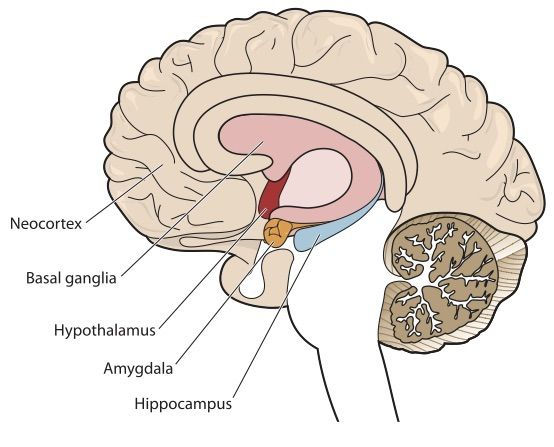
So we've all heard that meditation is essential when it comes to mental health. Why is that? How does it actually affect the brain? Well, here's your brief overview and a little bit of science to get you inspired to meditate.
Meditation dynamics and positive affirmations have been increasing with scientific research to find out the mechanism of actions behind the traditionally used action (Lippelt, 2014). Meditation has been shown to reduce stress, adapt the mind, and have significant effects on worldly/perceptual processing (Lippelt, 2014). There are varietal meditative practices; focused attention meditation (FAM), open-monitoring meditation (OMM), and loving-kindness meditation (LKM), all working systemically, however, has been shown to target different neural areas of the brain (Lippelt, 2014).
Meditation has shown to improve conflict resolution by strengthening network efficiency within the anterior cingulate cortex (ACC) associated with self-regulation, errors, and overcoming impasses (Lippelt, 2014). Meditation has proven to significantly increase hippocampal grey matter volumes, local radial distances, and enhanced white matter fiber integrity; particularly with increased meditative time/experience (Luders, 2013). White matter is compounded by axons and connecting tissue to help neural signaling conduction, whereas grey matter is containing cell bodies, dendrites, synapses, and neuronal axon terminals (Luders, 2013). So pretty much, if you want increased ability to deal with your emotions and enhance your cognition, meditate! The hippocampus is a central regulator for memory encoding and retrieval processing, the subiculum is correlated to episodic recollection and how individuals re-experience past events (Luders, 2013). When we continuously re-live painful past experiences, our bodies do not understand the difference of it actually occurring. These memories can continue creating the same stress response and with it, the same inflammatory cascade.

Brief overview of the hypothalamic-pituitary-adrenocortical (HPA) axis communications.
The increased subiculum in meditators may contribute to reduced reactivity in every day and traumatic occurrences, and the ability to innately choose mindfully how their behavior will impact their outcome - uh yes please! This is an ideal way to learn how to control your emotions by facing your own demons internally (Luders, 2013). The hippocampal-amygdaloid transition area also showed statistical importance with meditative stress reduction. The hypothalamic-pituitary-adrenocortical (HPA) axis reduced prolonged glucocorticoid synthesis, neurotoxicity, and potential neurogenesis promotion (Luders, 2013).

Meditation reduces the amygdala, a neural component of the brain associated with the positive and negative encoding of; emotion, ambiguous stimuli, safety/threats, appraisal, and emotionally significant events (Desbordes, 2012). The amygdala increases upon dispositional negativity and decreases in emotional regulation of reappraisal, and cognitive distancing. This can be impaired by mental health disorders; stress, anxiety, depression, PTSD, etc. (Desbordes, 2012). The amygdala correlates with spontaneous emotional reappraisal and suppression, with the former positively impacting interpersonal psychological well-being (Desbordes, 2012). If you're suffering from mental health issues, this is a free practice to try and incorporate into your daily routine.
A 2013 randomized controlled study reviewed regular mindfulness meditation over an 8-week period concluding a statistically relevant reduction in anxiety, distress ratings, stress, social stress, and negative self-statements (Hoge, 2013).
Overall, mindfulness and meditation is an important part of healing and nourishing the neural pathways for psychological welfare. Has meditation helped you? Let me know in the comments!
References
Ahlawat, P. K. (2012). Therapeutic benefits of Withania somnifera: An Exhaustive Review. INTERNATIONAL JOURNAL OF PHARMACEUTICAL AND CHEMICAL SCIENCES , 1(2), 491-496.
Deepali, M. K. (2016). The Molecular Links of Re-Emerging Therapy: A Review of Evidence of Brahmi (Bacopa monniera). Frontiers in Pharmacology , 7, 44.
Desbordes, G. N. (2012). Effects of mindful-attention and compassion meditation training on amygdala response to emotional stimuli in an ordinary, non-meditative state. . Frontiers in Human Neuroscience, 6.
Friedman, M. (2013). Thyroid Autoimmune Disease. Journal of Restorative Medicine, 2(1), 70-81.
Gannon, J. M. (2014). Subtle changes in thyroid indices during a placebo-controlled study of an extract of Withania somnifera in persons with bipolar disorder. Journal of Ayurveda and integrative medicine, 5(4), 241–245.
Hoge, E. A. (2013). Randomized Controlled Trial of Mindfulness Meditation for Generalized Anxiety Disorder. . The Journal of Clinical Psychiatry, 74(8), 786–792.
Hong‑Yan, S. L.‑Z.‑C.‑D.‑J. (2017). Antitumor activity of fucoidan in anaplastic thyroid cancer via apoptosis and anti-angiogenesis. Molecular Medicine Reports, 15(5), 2620-2624.
KUMAR, P. J. (2016). PHARMACOGNOSTIC AND PHARMACOLOGICAL ASPECT OF BACOPA MONNIERI: A REVIEW. Innovare Journal of Ayruvedic Sciences, 4(3), 295-301.
Lippelt, D. P. (2014). Focused attention, open monitoring and loving kindness meditation: effects on attention, conflict monitoring, and creativity – A review. . Frontiers in Psychology, 5(1).
Luders, E. K. (2013). Meditation effects within the hippocampal complex revealed by voxel-based morphometry and cytoarchitectonic probabilistic mapping. Frontiers in Psychology, 4.
Sharad, P. a. (2015). Diagnosis and management of primary hypothyroidism in Traditional Chinese Medicine (TCM) and Traditional Indian Medicine (Ayurveda). International Journal of Clinical Endocrinology and Metabolism , 1(1), 009-012.
Stansbury, J. S. (2012). Promoting Healthy Thyroid Function with Iodine, Bladderwrack, Guggul and Iris. Journal of Restorative Medicine, 1(1), 83-90.
Stansbury, J. S. (2012). Promoting Healthy Thyroid Function with Iodine, Bladderwrack, Guggul and Iris. . Journal of Restorative Medicine, 1(1), 83–90. .
Ulbricht, C. B. (2013). Seaweed, Kelp, Bladderwrack (Fucus vesiculosus): An Evidence-Based Systematic Review by the Natural Standard Research Collaboration. . Alternative and Complementary Therapies, 19(4), 217–230.
Comments